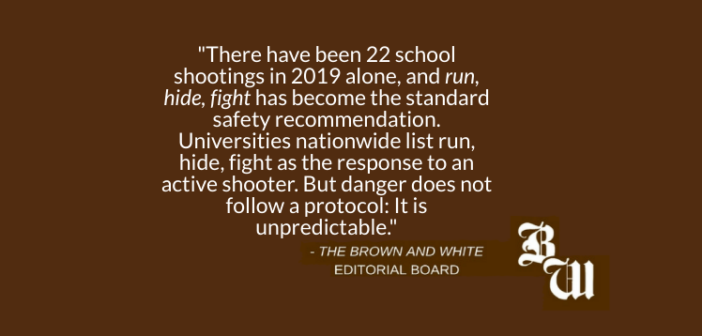Run, hide, fight.
This is the safety protocol laid out by U.S. Department of Homeland Security in the incident of an active shooter. As students go through grade school and high school, the routine could become normal. A lockdown drill may be as ordinary as a school assembly.
There have been 22 school shootings in 2019 alone, and run, hide, fight has become the standard safety recommendation. Universities nationwide list run, hide, fight as the response to an active shooter. But danger does not follow a protocol – It is unpredictable.
Monday afternoon, Lehigh University Police detained a student armed with a loaded gun and knife after he had threatened to “kill (them) all.”
According to a Hawkwatch alert sent to students, “LUPD officers were en route to the student’s residence when officers witnessed the public disturbance.” Thankfully, another student had reported concerning behavior the night before, and the Hawkwatch stated: “The reporting student’s actions alerted us to the problematic behavior and helped us resolve the problem without anyone getting hurt.”
The reporter’s persistence and LUPD’s immediate response to the threat is commendable. Officers put their safety on the line, protecting the campus from potential danger.
Within an hour, students were back to their normal routines. Students walked into Saxbys, studied in Farrington Square and rushed across campus to make classes.
We thank the LUPD for continuing to create a campus environment where safety is the norm.
Officers provided secure scene for student journalists to break the news, which we could not have done without their extensive efforts to control the dangerous situation.
A campus-wide email sent by the LUPD stated that the situation Monday did not lead to a campus lockdown or extensive emergency procedures because “Overuse of (their) emergency communication systems could diminish their impact in truly critical situations, and (they) want members of our campus community to understand that if and when they receive notifications through all these methods, they need to pay attention to what is being communicated.”
And while Monday’s incident was not defined as a critical situation, it is important to use this experience to reflect on the importance of campus safety.
Run, hide, fight. Some of us learned this before we learned to write in cursive. But danger is unpredictable.
On Monday afternoon, students’ daily routines were interrupted by danger, and it became apparent that we must prioritize one aspect of our routine, campus safety.
Lehigh University offers a general protocol for students to follow in case of an active shooter. The guide reminds us to “stay calm,” and of course, “Run, hide, fight.”
Although LUPD responded almost immediately, what we do prior to their arrival is critical.
The San Francisco police boasts the quickest average police response time, taking an average of 5.46 minutes to respond to a distress call. Other city police departments average a window of up to 15 minutes between a call and police action.
The window of time between call and response can be what determines life or death.
LUPD offers resources such as active shooter preparation and self-defense classes, but without required campus safety drills, our student body risks freezing when confronted by a truly dangerous situation.
It is up to the administration, faculty and students to prioritize safety on campus. Instead of optional classes, we need to implement mandatory drills.
Instead of hearing run, hide, fight, we must practice it. If danger is unpredictable, our response cannot be.
Yes, we deserve to feel safe on campus, but the assumption that our campus is protected by LUPD is not enough. Yes, we should feel safe in our routines. But campus safety requires a holistic effort from all departments and demands a commitment to an effective response to danger. Safety is not optional. It is mandatory.
As a campus, we can do more to look after each other. Eventual threats to campus safety could reveal themselves overtime. If you see something, say something. We must take an active role in reporting direct threats to our campus.
The reporter’s actions protected our student body from what could have been a more dangerous situation.
Run, hide, fight. But first, look out for each other. If we can do that, we can truly prepare for a dangerous situation.






Comment policy
Comments posted to The Brown and White website are reviewed by a moderator before being approved. Incendiary speech or harassing language, including comments targeted at individuals, may be deemed unacceptable and not published. Spam and other soliciting will also be declined.
The Brown and White also reserves the right to not publish entirely anonymous comments.
2 Comments
You guys should be asking questions about what threats are being reported and managed that you’re not hearing about. The Clery Act, passed over Lehigh’s strenuous objections after Jeanne Clery was killed on campus when I was a student, covers only violent acts that have already been committed. Current best practices for threat assessment do not include notifying campus communities until a threat is imminent. But you have, essentially, no idea what lower-level dangers exist: for instance, someone who’s made threats and was positioned to carry them out, is still physically capable of walking onto campus and potentially armed, but is currently not judged by a few people in a threat assessment office to be an immediate threat.
You and your parents need to be talking with administration and campus police to come up with a plan for making the community aware of lethal threats when they’re known, but before they actually involve someone running around on campus with weapons. If you ask about what such threats have existed in the last five years, I bet you’ll be surprised by the response.
Sorry, correction: the Clery Act also requires campus-community notification in the event of an immediate threat. Again, though, “yellow alert”-type problems are not something that has to be reported, and it’s up to individual campuses to decide how they want to handle these things, who should be notified about them.